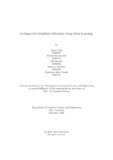| dc.contributor.advisor | Hossain, Muhammad Iqbal | |
| dc.contributor.author | Paul, Annay | |
| dc.contributor.author | Dey, Binayak Kumar | |
| dc.contributor.author | Mostafa, Md | |
| dc.contributor.author | Mosfakin, Maharin | |
| dc.contributor.author | Tonika, Rukshana Amin | |
| dc.date.accessioned | 2023-10-16T04:53:30Z | |
| dc.date.available | 2023-10-16T04:53:30Z | |
| dc.date.copyright | ©2022 | |
| dc.date.issued | 2022-09-28 | |
| dc.identifier.other | ID 18301097 | |
| dc.identifier.other | ID 18301054 | |
| dc.identifier.other | ID 18301132 | |
| dc.identifier.other | ID 18301119 | |
| dc.identifier.other | ID 18301247 | |
| dc.identifier.uri | http://hdl.handle.net/10361/21834 | |
| dc.description | This thesis is submitted in partial fulfillment of the requirements for the degree of Bachelor of Science in Computer Science, 2022. | en_US |
| dc.description | Cataloged from PDF version of thesis. | |
| dc.description | Includes bibliographical references (pages 30-32). | |
| dc.description.abstract | With the emergence of Generative Models for creating Deepfake images, and videos
of high quality, which are extremely realistic and hard to recognize, several social,
and political issues have come to light. DeepFakes of celebrities and political personalities are used to exploit and spread misinformation that leads to several social
and political unrest. Hence, the necessity to develop a methodology to detect such
images and videos created with DeepFakes has arisen in recent times. Several state-
of-the-art methodologies are in use for the purpose such as CNN, RNN, reverse
engineering of GMs, neural networks, ensemble-based learning approaches, etc. As
many machine learning-based approaches are already adopted, our aim is to improve
the quality of detection of DeepFakes using models that utilize deep learning, in our
study. The state-of-the-art methodologies have shown promising results when ap-
plied to popular datasets vastly used for training and research purposes. However,
most methods are not robust enough to perform well in all kinds of general-purpose
DeepFakes. Hence, in this paper, we have developed a new comprehensive and ef-
ficient framework that improves the DeepFake detection performance not only on
general purpose but also on training purpose data. | en_US |
| dc.description.statementofresponsibility | Annay Paul | |
| dc.description.statementofresponsibility | Binayak Kumar Dey | |
| dc.description.statementofresponsibility | Md Mostafa | |
| dc.description.statementofresponsibility | Maharin Mosfakin | |
| dc.description.statementofresponsibility | Rukshana Amin Tonika | |
| dc.format.extent | 42 pages | |
| dc.language.iso | en | en_US |
| dc.publisher | Brac University | en_US |
| dc.rights | Brac University theses are protected by copyright. They may be viewed from this source for any purpose, but reproduction or distribution in any format is prohibited without written permission. | |
| dc.subject | Deepfake | en_US |
| dc.subject | GAN | en_US |
| dc.subject | CNN | en_US |
| dc.subject | Reverse engineering of GM’s | en_US |
| dc.subject | RNN | en_US |
| dc.subject.lcsh | Online manipulation--Prevention | |
| dc.subject.lcsh | Deepfakes | |
| dc.title | An improved deepfake detection using deep learning | en_US |
| dc.type | Thesis | en_US |
| dc.contributor.department | Department of Computer Science and Engineering, Brac University | |
| dc.description.degree | B.Sc. in Computer Science | |

